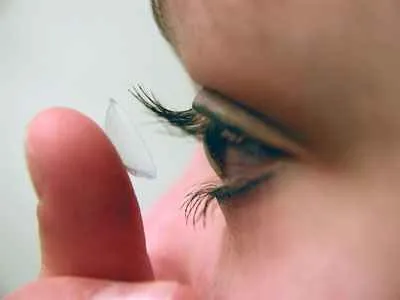 Contact lenses small made from transparent materials lenses, worn directly on the eye for vision correction (i.e., to improve visual acuity).
Contact lenses small made from transparent materials lenses, worn directly on the eye for vision correction (i.e., to improve visual acuity).
Contact lenses, according to experts, are about 125 million people in the world. Method of vision correction using contact lenses is called contact vision correction.
Almost 50% of those who wear contact lenses, are young people aged 18 to 25 years. And among those who wear contact lenses for the first time, the proportion of young people under the age of 35 years, almost 90 %.
The story of the creation of contact lenses starts with the name of Leonardo da Vinci. In 1508, he designed the device in a transparent globe filled with water, through which people with poor eyesight can see better.
Almost 150 years later in 1637 the French mathematician and philosopher Rene Descartes proposed to use a tube with water at the end of which was fastened a magnifying glass. In 1887 a glassblower from the German town of Wiesbaden made the first eye lens. One of his friends was missing an eyelid,and it is, as the famous world, protects the eyes and prevents drying of the cornea. Muller made of glass spherical lens and put it on the eyes to prevent moisture loss. This patient wore the lens for more than 20 years, and with age when vision began to deteriorate, he noticed that the eyes with the lens sees much better than the other. The first real contact lenses, which keep the eye appeared in 1888. The Swiss ophthalmologist Adolf Fick invented the contact lens. This lens was made of glass and covering the entire surface of the eye. Adolf Fick oblikovan an article which wrote about his invention: “Glass cornea with a radius of curvature of 8 mm is sitting with a basis in a 7 mm glass sphere , the latter has Cherno 3 mm and meets the ball with a radius of curvature of 15 mm. Glass the cornea with parallel walls inside and outside, ground and polished; similarly ground and polished and free edge of the glass of the sclera. Weight some contact points, 0.5 oz.” The first mass production of special sets of contact lenses was organized by Carl Zeiss. Each kit consisted of lenses with different parameters, making it easier to find the right pair for each eye of a particular person. Until the mid 50-ies of the contact lenses were created of glass and only had the same dimensions : a diameter of 20-30 mm, a thickness of 1-2 mm. They covered almost the entire visible surface of the eye – the cornea and the sclera. As a result they often accumulate fluid, causing swelling of the corneal membrane and, as a result, image distortion and pain. After removing the lenses, patients had to be treated for a long time to vosstanovit normal transparency of the cornea. In 1947 Kevin tuki suggested lenses that size was much smaller than its predecessors and covered only the cornea. But still these lenses were made of hard plastic, irritating to the eyes and created discomfort to its user. And in 1960, the Czech scientist Otto Vahteri and engineer Dragoslav lim synthesized a new material for the production of contact lenses. This material had a unique ability to absorb water up to 38% of its own weight and after saturation with water becomes very soft and basicname, while still flowing oxygen to the cornea. It is from this polymer made the first contact lens as we know it now. Surprisingly, for its production of scientists used a device consisting of children’s designer and bike – this miracle machine is still kept at the Czech Museum. Since contact lenses became available for everyone. Improving soft contact lenses, in the 70-ies of the last century in the United States, scientists are designing hydrogel materials, and in 1999 appear breathable silicone hydrogel contact lenses. Due to the high elasticity and permeability to oxygen, these lenses are very comfortable. Modern contact lenses are very thin, soft and transparent film which is placed on the surface of the eye. They are manufactured using innovative technologies that allow the eyes to breathe, and the lenses stay moist and comfortable eye. Today to find a suitable lens people can not only nearsightedness and farsightedness, but also astigmatism and presbyopia. In addition, there are colored contact lenses for those who want to temporarily change eye color or to hide any defect.
Atideo:

